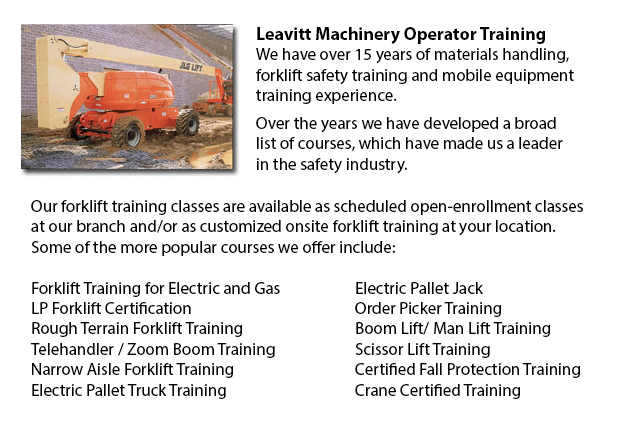
Oshawa Aerial Lift Safety Training - Each and every year, there are approximately 26 construction fatalities due to the use of aerial lifts. Most of the craftsmen killed are laborers, electrical workers, carpenters, painters or ironworkers. The majority of the fatalities are caused by falls, tip-overs and electrocutions. The greatest danger is from boom-supported lifts, like for instance bucket trucks and cherry pickers. The majority of the deaths are related to this type of lift, with the rest involving scissor lifts. Other dangers include being struck by falling things, being thrown out of a bucket, and being caught between the lift bucket or guardrail and an object, like a joist or steel beam.
To be able to operate an aerial lift safely, perform a check on the following things prior to using the device: emergency and operating controls, safety devices (e.g., outriggers and guardrails), personal fall protection gear, and wheels and tires. Check for possible leaks in the air, hydraulic fluid and fuel-system. Inspect the device for missing or loose components.
The place where the device would be utilized should be carefully checked for possible dangers, like holes, bumps, drop-offs and debris. Overhead power lines should be avoided or closely monitored. It is recommended that aerial lift devices be used on surfaces which are level and stable. Don't work on steep slopes that go beyond slope restrictions that the manufacturer specified. Even on a slope that is level, wheel chocks, outriggers and brakes must be set.
Employers are required to provide aerial lift operators and maintenance mechanics with the correct manuals. Operators and mechanics need to be trained by a certified individual experienced with the relevant type of aerial lift.
Aerial Lift Safety Tips:
o Before operating, close doors and lift platform chains.
o Climbing on and leaning over guardrails is prohibited. Stand on the floor of the bucket or platform.
o Stay within manufacturer's load-capacity restrictions.
o Use work-zone warnings, like for instance cones and signs, when working near traffic.
If correct procedures are followed, electrocutions are avoidable. Stay at least 10 feet away from whichever power lines and qualified electricians should de-energize and/or insulate power lines. Workers need to make use of personal protective tools and equipment, such as a bucket that is insulated. Then again, a bucket that is insulated does not protect from electrocution if, for instance, the worker touches a different wire providing a path to the ground.
Falls are avoidable if the worker remains secure inside guardrails or within the bucket by using a positioning device or a full-body harness. If there is an anchorage inside the bucket, a positioning belt together with a short lanyard is acceptable.
Tip-overs are avoidable by following the manufacturer's directions. Unless the manufacturer specifies otherwise, never drive whilst the lift platform is elevated. Adhere to the device's vertical and horizontal reach restrictions, and never go beyond the specified load-capacity.
-
Oshawa Scissor Lift Operator Certification
Oshawa Scissor Lift Operator Certification - North American regulators recommend that worksites need operators of scissor lifts, booms or aerial work platforms to obtain certification training. Scissor lift operator certification is not mandatory, bu... More -
Narrow Aisle Forklift / Order Picker Training / Electric Pallet Jack / Electric Pallet Truck Training in Oshawa
A pallet lift is a model of equipment dedicated in the moving of pallets of many dimensions and weights. They might be utilized as an appendage for platform lifts, cranes and other types of heavy machinery or be applied on their own. Pallet hoists ar... More -
Oshawa Crane Operator Certification
Oshawa Crane Operator Certification - The process to permit people to be able to operate certain kinds of cranes is to take crane operator certification training to get certification. The certification process incorporates classroom learning, hands-o... More -
Oshawa Aerial Platform Training
Oshawa Aerial Platform Training - Aerial platform lifts might be utilized to accomplish a lot of unique tasks executed in hard to reach aerial places. A few of the odd jobs associated with this style of lift include performing routine repair on build... More -
Oshawa Forklift Certification Schools
Oshawa Forklift Certification Schools - Forklift Certification is mandatory within North America. Hence, forklift training programs are important both for companies and for people seeking jobs in industries as forklift operators. Forklift training fo... More -
Oshawa Heavy Equipment Ticket
Oshawa Heavy Equipment Ticket - Depending on the nature of the job at hand, the type of construction equipment that a heavy equipment operator makes use of varies. Each and every type of machine is built to perform specific jobs in the most effective... More -
Oshawa Heavy Equipment Certification
Oshawa Heavy Equipment Certification - Large pieces of machines and heavy-duty vehicles are usually known as heavy equipment. This broad term includes utility vehicles from forestry and agricultural implements to civil engineering vehicles, construct... More -
Oshawa Overhead Crane Safety Training
Oshawa Overhead Crane Safety Training - The overhead crane safety training program is meant to equip the operators with the right skills and knowledge in the areas of: crane safety precautions, accident avoidance, materials handling, and equipment an... More

Forklift Certification Oshawa
TOLL FREE: 1-888-254-6157
Oshawa, Ontario
forkliftcertificationoshawa.com
Email Us
About Us


